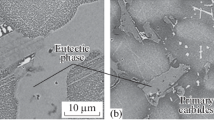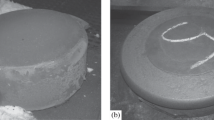Summary
Nickel-base alloys, as designed for gas turbine use, have reached an interesting new level of technology. Where previously the main thrust of effort had been to improve mechanical capability, the problems of alloy phase stability and hot corrosion now control much alloy development, principally because of the need for increased alloy life and because gas turbines are being used in a wide variety of ambients. Fundamental and applied studies of hot corrosion phenomena are beginning to allow understanding and progress towards solution of the problem. Sodium sulfate has been the key reactant in the case of nickel alloys. Chromium, as an alloying element, helps inhibit hot corrosion, while molybdenum and aluminum appear to be a problem.
Utilizing basic concepts to apply knowledge of the tendency of solid solutions to form unwanted TCP phases, which destroy strength and disrupt ductility, combined with background information on the phases normally found in nickel alloys, a computer system to predict TCP phase formation has been developed. The system, called Phacomp, can classify and separate most nickel-base alloys, predicting whether they are free or prone from the deleterious phases.
Phacomp is and can be used to control or to evaluate production heats of superalloys. It can also be used as an alloy development tool, obviating much alloy preparation and testing, focusing attention on the stable compositions of interest. It may also have a future in other alloy systems.
Similar content being viewed by others
References
F. Raymond: Effects of Heat Treatment on the Microstructure and Notch Ductility of Two Age-Hardenable Ni-Cr-Fe Base Alloys, presented at the 95th AIME Annual Meeting, New York City, Feb. 28, 1966.
H. J. Beattie, Jr., and W. C. Hagel: Trans. Met. Soc. AIME, 1965, vol. 233, no. 2, pp. 277–287.
J. F. Barker: General Electric Co. FPD/TIS Report R65FPD51 (Feb. 5, 1965).
S. T. Wlodek: Trans. Am. Soc. Met., 1964, vol. 57, pp. 110–119.
E. W. Ross: Recent Research on IN-100, presented at the 92nd AIME Annual Meeting, Dallas, Texas, February 1963.
R. McCracken: Thompson-Ramo-Wooldridge Co. Report TM-3540-67 (Nov. 16, 1962).
E. L. Simons, H. A. Liebhafsky, and G. V. Browning: Corrosion, 1955, vol. 11, no. 12, p. 505.
A. U. Seybolt and A. M. Beltran: Observations on the High-Temperature Sulfur-Oxygen Corrosion of Nickel and Cobalt, presented at the ASTM Symposium on Hot Corrosion, Atlantic City, N. J., June 30, 1966.
R. W. Hardt, J. R. Gambino, and P. A. Bergman: Marine Hot Corrosion Mechanism Studies, ibid.
P. A. Bergman, C. T. Sims, and A. M. Beltran: Development of Hot Corrosion-Resistant Alloys for Marine Gas Turbines, ibid.
S. T. Wlodek: Trans. Met. Soc. AIME, 1964, vol. 230, no. 8, pp. 1078–1090.
W. J. Boesch and J. S. Slaney: Met. Progr., 1964, vol. 86, no. 7, pp. 109–111.
P. Greenfield and P. A. Beck: Trans. AIME, 1956, vol. 206, pp. 265–275.
Electronic Structure and Alloy Chemistry of the Transition Elements, ed. by P. A. Beck, Interscience (New York), 1963.
L. R. Woodyatt, H. J. Beattie, and C. T. Sims: Periodic Group Effects and Phase Relationships to Stability of Nickel- and Cobalt-Base Superalloys and Stainless Steels, presented at the Fall Meeting of The Metallurgical Society, Philadelphia, Pa., Oct. 20, 1964.
L. R. Woodyatt, C. T. Sims, and H. J. Beattie: Trans. Met. Soc. AIME, 1966, vol. 236, no. 4, pp. 519–527.
L. Brewer: High-Strength Materials, ed. by Victor F. Zackay, Chapter 2, John Wiley and Sons (New York), 1965.
High-Temperature Materials Program Progress Report No. 55, Part A, GEMP-35A (Jan. 31, 1966), GE-NMPO, Evendale, Ohio.
F. C. Frank and J. S. Kasper: Acta Cryst., 1958, vol. 11, pp. 184–190; 1959, vol. 12, pp. 483–499.
D. K. Das, S. P. Rideout, and P. A. Beck: Trans. AIME, 1952, vol. 194, pp. 1071–1079.
P. A. Beck and W. D. Manley: Trans. AIME, 1949, vol. 185, p. 354.
H. J. Beattie, Jr., and W. C. Hagel: Trans. Met. Soc. AIME, 1961, vol. 221, no. 2, pp. 28–34.
W. J. Boesch and J. S. Slaney: Phase Stability in Wrought Precipitation-Hardened Nickel-Base Alloys, presented at the 95th AIME Annual Meeting, New York City, Feb. 28, 1966.
Author information
Authors and Affiliations
Rights and permissions
About this article
Cite this article
Sims, C.T. A contemporary view of nickel-base superalloys. JOM 18, 1119–1130 (1966). https://doi.org/10.1007/BF03378505
Published:
Issue Date:
DOI: https://doi.org/10.1007/BF03378505




